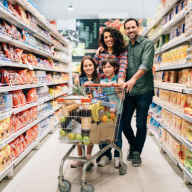8 Retail predictions for 2021

Retail
191 week ago — 9 min read
With so much uncertainty and volatility in the economy, it may be foolhardy to go out on a limb with any predictions. My crystal ball has certainly been faulty more than a few times. Nevertheless, I throw caution to the wind with my (mostly) educated guesses on what will turn out to be noteworthy in the VUCA world of retail this year.
1. The great acceleration moderates
Perhaps the biggest COVID-19 related headline of 2020 was how just about every retail trend accelerated, most notably digital commerce. While directionally correct, the idea that most retailers experienced 10 years of e-commerce growth in a matter of weeks was, rather predictably, flat out wrong. It turned out to be much more like two to three years in most categories.
We can expect many of the pandemic induced distortions to begin to ease as well, driven by fewer big ticket one-time purchases and a slow but inevitable rebalancing away from the dominance of essentials buying toward more want-driven shopping.
The huge spike in online shopping penetration we saw last spring has already moderated, but we can expect many of the pandemic induced distortions to begin to ease as well, driven by fewer big ticket one-time purchases and a slow but inevitable rebalancing away from the dominance of essentials buying toward more want-driven shopping.
2. Physical retail: Still not dead
Even with a huge boost to e-commerce, software hasn’t come close to eating retail. Brick & mortar stores are still overwhelmingly where most transactions are rung up. Despite a huge number of store closings, dozens of well-known brands across a spectrum of categories in the US opened more than 4,000 locations last year. Moreover, many brands (Five Below, Tractor Supply, Ulta, just to name a few) announced they are planning to open a lot of new outlets. Two companies you might have heard of—Walmart and Amazon—are making huge investments in physical stores as well.
Also read: How to have the perfect mix of a phygital (physical + digital) store?
3. Bifurcation 2.0 and the hollowing out of the mediocre middle
The long-term trend of success being found at either end of the value spectrum has been called out by myself and others for years. The unsustainability of ‘slow-to-innovate’ retailers, certain formats and (perhaps) the majority of shopping centres swimming in a sea of sameness has been building. But the coronavirus crisis is making this reckoning happen faster and with greater force. What many dub the “retail apocalypse” is actually rather focused and largely the inevitable collapse of the middle and the elimination of the increasingly useless middleman.
A new phase of bifurcation is also evident in the so-called K-shaped recovery, characterized by the rich getting richer and spending more— and driving success for certain kinds of retailers. Conversely, a large chunk of society has been hit hard by the ravages of the pandemic and are decidedly less well off, causing a pullback in spending and/or a ‘trading down’ to more value-oriented retailers. This tale of two cities will grow even more pronounced.
4. The hybridization of retail takes centre stage
The creation or rapid adoption of hybrid models has characterized many parts of our lives. Just about everything—from how school and work get done, to how we exercise and attend industry conferences—is moving to some form of physical and digital hybrid. For retail this is hardly new. The reality that the customer is the channel and that remarkable retailers must strive to provide a harmonized experience has been emerging for well over a decade.
Despite the growing blur between the physical and digital worlds, stores themselves have not changed all that much. Yet, a rapidly growing percentage of what gets called ‘e-commerce’ actually involves a store, given the growing role of ship-from-store, BOPIS (Buy online, pickup in store) and curbside pickup. This phenomenon will drive a radical rethink of the role and configuration of brick & mortar locations. More must become hybrids: part places to buy things, part showrooms, part inspiration source, part service hub, part brand billboard, part fulfilment centre.
5. Grocery wars escalate
Despite all the awful outcomes from the pandemic, if you sell ‘essential’ items you’ve done pretty well. Nowhere is this truer than the supermarket business. The shift away from eating out to eating at home drove record spending and also jump-started previously rather moribund grocery delivery and click & collect adoption. It also tended to mask the profit challenges of home delivery and growing competitive intensity. By the latter part of this year, the expansion of Amazon Fresh will loom large and, as ‘comping’ last year’s numbers will be next to impossible, a race to the bottom may well break out. And to paraphrase Seth Godin, the problem with the race to the bottom is you might win. Or worse, finish second.
6. Work from wherever rewires retail real estate strategy.
The profound shift to work-from-home was one of the most impactful underlying retail trends, driving distorted spending in everything from office supplies, to home furnishings, to work-out equipment and more during the past year. With uncertainty around the pace of vaccinations and potential complications from new Coronavirus strains, it remains unclear how quickly we will be in a truly post-COVID world. Yet as Derek Thompson argues in The Atlantic, the remote work revolution will reshape where people live and overall consumption patterns. The first part of 2021 is still likely to be more about what and how we buy. But more and more, it will become about where we buy it. Once hot retail cities and neighborhoods will become less so. “The great acceleration” may well yield to what Scott Galloway calls “the great dispersion.”
7. Cheap(er) real estate creates new brick & mortar opportunities.
2020 was a record for store closings in the United States and at least one major research firm predicts another record will be set this year, with some 10,000 outlets shuttering. With rents coming down in many trade areas —and in some cases plummeting—interesting new physical store opportunities will emerge.
We are already starting to see this with newer digitally native vertical brands like Allbirds getting more aggressive with store roll-outs, established retailers like Nike, Macy’s and Nordstrom investing behind small format locations and many vendors accelerating their direct-to-consumer strategies, often doubling down on brick & mortar investments.
8. Without a return to fun, we won’t see a luxury and fashion recovery.
2020 was a pretty horrific year to be in the apparel business, broadly, and the higher-end, fashion part of it, in particular. Indeed, why get dressed up if there is no place to go? While the core luxury customer is pretty flush from stock market gains and increased discretionary income, much of the sector’s spending is driven by products purchased for “wearing occasions” that largely went away due to the pandemic. The social aspect of shopping is also critical to most luxury and fashion expenditures. Even under a best case recovery scenario, with relatively few fun things to go do—and feeling like fully engaging in the more immersive aspects of physical shopping cannot be done in a relaxed and enjoyable manner—we aren’t like to witness much of a recovery this year.
Also read: What Covid-19 has taught us
To explore business opportunities, link with us by clicking on the 'Invite' button on our eBiz Card.
Image source: shutterstock.com
Article source: STOrai Magazine. Article author Steve Dennis is a consultant, speaker and writer on retail innovation, omni-channel strategy and marketing personalization. As President of SageBerry Consulting, he leverages over 30 years of experience to help retail and luxury industry clients accelerate their growth and become more customer-centric.
Disclaimer: The views and opinions expressed in this article are those of the author and do not necessarily reflect the views, official policy or position of GlobalLinker.
View STOrai 's profile
SME Inspirations
Other articles written by STOrai Magazine
Enhanced Brand Storytelling in the Digital Age
28 week ago
Most read this week

















Comments
Please login or Register to join the discussion